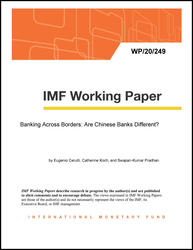
Banking Across Borders: Are Chinese Banks Different?
Banking Across Borders: Are Chinese Banks Different?
READ MORE...
Volume/Issue:
Volume 2020
Issue 249
Publication date: November 2020
ISBN: 9781513561226
$18.00
Add to Cart by clicking price of the language and format you'd like to purchase
Available Languages and Formats
| English |
Prices in red indicate formats that are not yet available but are forthcoming.
Topics covered in this book
This title contains information about the following subjects.
Click on a subject if you would like to see other titles with the same subjects.
Banks and Banking , Exports and Imports , Money and Monetary Policy , Chinese banks , Trade , FDI , Gravity model , WP , borrower country , cross-border lending , EMDE borrower , bank lending , lending bank , parent country , Cross-border banking , portfolio investment , Chinese bank , U , S , dollar , Bank credit , Portfolio investment , Foreign direct investment , Foreign banks , Global
Summary
We explore the global footprint of Chinese banks and compare it with that of other bank nationalities. Chinese banks have become the largest cross-border creditors for almost half of all emerging market and developing economies (EMDEs). Their global reach resembles that of banks from advanced economies (AEs). We take a nationality approach as international banks, and Chinese banks in particular, grant a substantial share of their cross-border loans from affiliates located abroad. But differences remain. Using a gravity model with a novel measure of distance capturing the role of foreign affiliates across all bank nationalities, we find that larger distances deter cross-border bank lending to EMDEs more than to AEs. For Chinese banks, however, distance deters lending to EMDEs less than for peer EMDE banks. We show that for all banks combined, bilateral economic interactions like trade, FDI and portfolio investment, positively correlate with lending. Chinese banks’ lending to EMDEs also strongly correlates with trade, but not with FDI and, unlike other banks, it correlates negatively with portfolio investment.
Copyright © 2010 - 2024
Powered by:
AIDC



